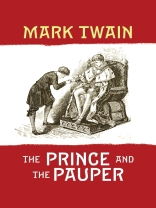'When I am king, they shall not have bread and shelter only, but also teachings out of books; for a full belly is little worth where the mind is starved, and the heart.’ – Mark Twain
Mark Twain’s 1881 historical satire
The Prince and the Pauper is a classic adventure of mistaken identity that champions social justice. Set in two very different socioeconomic worlds of 16th-century England, this treasured classic tells the story of two young boys who were born on the same day and are identical in appearance—Tom Canty, a penniless pauper, and Edward VI son of Henry VIII of England and heir to the throne—who, through a series of events, switch places and live each others’ lives.
During a chance encounter the two boys, born in rival social classes in Tudor London, realize that they are identical and amused by how similar they look, decide it would be fun to swap clothes and exchange roles — a game that briefly, but drastically, alters the lives of both of them.
The Prince, dressed in rags, wanders about the city’s bustling neighborhoods among the lower classes and endures a series of hardships. Tom, now living with the royal family, is constantly filled with dread, fearful of being discovered for who and what he really is.
This satirical novel about the thin line that separates prince and pauper is brimming with humor, rising tension and visual detail, and remains one of Twain’s most popular and best-loved novels of all time,
O autorze
Mark Twain, the pen name of Samuel Langhorne Clemens, was an American writer, humorist, and essayist. Born in 1835, Twain was a printer in several cities and briefly served in a Confederate militia. He also held a steamboat pilot’s license, a career he loved. Twain is best known for his classic novels The Adventures of Tom Sawyer (1876) and its sequel, Adventures of Huckleberry Finn.







![Pokrywa Bernadette Andrea: Grace Norton [Gethin] and Frances (Freke) Norton Pokrywa Bernadette Andrea: Grace Norton [Gethin] and Frances (Freke) Norton](https://static.worldofdigitals.com/thumb_webp/264/9781351932264.webp)




